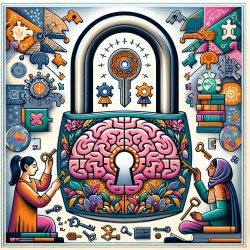In the evolving field of speech-language pathology, innovative and integrated approaches can significantly enhance therapy outcomes for children with hearing impairments. One such promising approach is Auditory-Verbal Music Play Therapy (AVMPT), as detailed in the research article titled "Auditory-Verbal Music Play Therapy: An Integrated Approach (AVMPT)" by Esmaeilzadeh, Sharifi, and Tayarani Niknezhad (2013). This integrated method combines the principles of Auditory-Verbal Therapy (AVT), Music Therapy (MT), and Play Therapy (PT) to create a holistic therapeutic strategy.
Key Findings from AVMPT Research
The research highlights several key outcomes that practitioners can implement to improve their skills and therapy effectiveness:
- Early Diagnosis and Intervention: The importance of early diagnosis and immediate intervention is underscored. Early detection, particularly within the first six months of life, combined with the use of appropriate hearing technology, can significantly enhance language development.
- Integrated Approach: AVMPT leverages the strengths of AVT, MT, and PT. This integration helps in the comprehensive development of communication skills, leveraging auditory stimulation, musical engagement, and play-based learning.
- Parental Involvement: AVT principles emphasize the role of parents as primary facilitators of their child's listening and spoken language development. Guiding and coaching parents to create supportive environments is crucial.
- Neuroplasticity and Brain Development: The integrated approach of AVMPT enhances neuroplasticity by engaging multiple sensory modalities. Music and play stimulate various brain regions, aiding in language acquisition and emotional development.
Practical Implementation Strategies
To incorporate AVMPT into practice, consider the following strategies:
- Create a Structured Environment: Set up a physical and acoustic space conducive to learning, free from distractions.
- Use Music and Rhythm: Integrate musical elements into therapy sessions. Use songs, rhythms, and musical instruments to engage children and reinforce language concepts.
- Role-Playing and Play-Based Learning: Utilize play therapy techniques to create scenarios that mimic real-life situations. Role-playing can help children understand and use new vocabulary in context.
- Parental Guidance: Train parents to use AVT techniques at home. Encourage them to engage in musical activities and play-based learning with their children.
- Continuous Assessment: Regularly assess the child's progress using formal and informal diagnostic tools. Adjust therapy plans based on these assessments to ensure effective learning.
Encouraging Further Research
While the integration of AVT, MT, and PT shows promising results, further research is needed to explore the full potential of AVMPT. Practitioners are encouraged to conduct studies and share their findings to contribute to the growing body of knowledge in this field.
To read the original research paper, please follow this link: Auditory-Verbal Music Play Therapy: An Integrated Approach (AVMPT).










